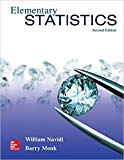
Concept explainers
Native languages: The following frequency distribution presents the number of households (in thousands) categorized by the language spoken at home, for the cities of New York and Los Angeles in the year 2009. The Total column presents the numbers of households in both cities combined.

Source: US. Census Bureau
- Construct a frequency bar graph for each city.
- Construct a frequency bar graph for the total.
- Construct a relative frequency bar graph for each city.
- Construct a relative frequency bar graph for the total.
- Explain why the heights of the bars for the frequency bar graph for the total are equal to the sums of the heights for the individual cities.
- Explain why the heights of the bars for the relative frequency bar graph for the total are not equal to the sums of the heights for the individual cities.
a.
To construct:A frequency bar graph for each city.
Explanation of Solution
Given information:The following frequency distribution presents the number of households (in thousands) categorized by the language spoken at home, for the cities of NewYork and Los An
geles in the year 2009. The total column presents the number of households in both cities combined
| Language | New York | Los Angeles | Total |
| English | 4098 | 1339 | 5437 |
| Spanish | 1870 | 1555 | 3425 |
| Other Indo-European | 1037 | 237 | 1274 |
| Asian and Pacific Island | 618 | 301 | 919 |
.
Solution:
From the given table, the frequency bar graph for New York is given by
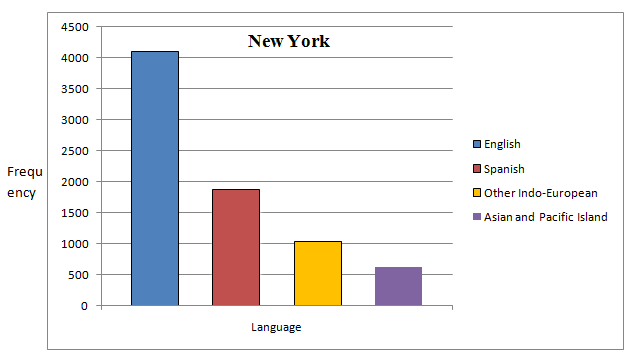
The frequency bar graph for Los Angeles is given by
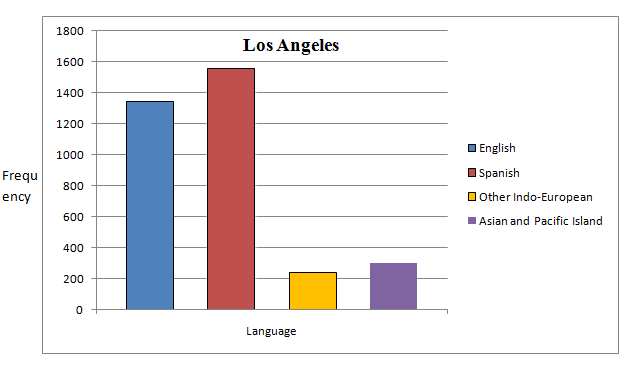
b.
To construct: A frequency bar graph for the total.
Explanation of Solution
Given information: The following frequency distribution presents the number of households (in thousands) categorized by the language spoken at home, for the cities of New York and Los An
geles in the year 2009. The total column presents the number of households in both cities combined
| Language | New York | Los Angeles | Total |
| English | 4098 | 1339 | 5437 |
| Spanish | 1870 | 1555 | 3425 |
| Other Indo-European | 1037 | 237 | 1274 |
| Asian and Pacific Island | 618 | 301 | 919 |
.
Solution:
From the given table, the frequency bar graph for the total is given by
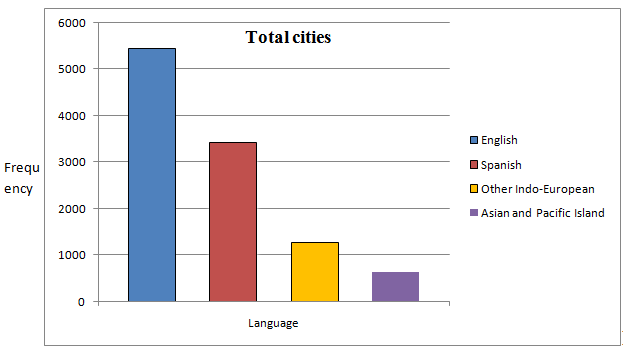
c.
To construct:A relative frequency bar graph for each city.
Explanation of Solution
The following frequency distribution presents the number of households (in thousands) categorized by the language spoken at home, for the cities of New York and Los An
geles in the year 2009. The total column presents the number of households in both cities combined
| Language | New York | Los Angeles | Total |
| English | 4098 | 1339 | 5437 |
| Spanish | 1870 | 1555 | 3425 |
| Other Indo-European | 1037 | 237 | 1274 |
| Asian and Pacific Island | 618 | 301 | 919 |
Formula used:
Solution:
From the given table,
The sum of all frequency for New York city is 7623.
The table of relative frequency for New York city is given by
| Language | New York | Relative Frequency |
| English | 4098 | |
| Spanish | 1870 | |
| Other Indo-European | 1037 | |
| Asian and Pacific Island | 618 |
From the given table, the relative frequency bar graph for New York is given by
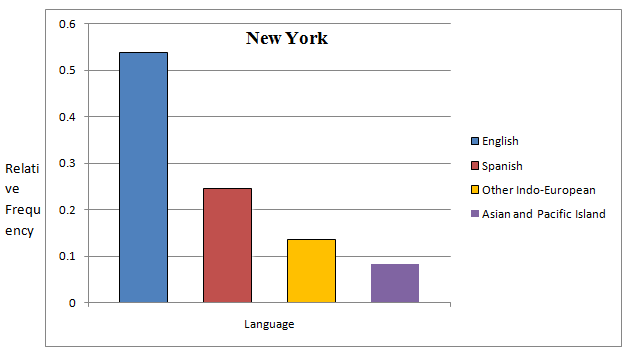
The sum of all frequency for Los Angeles is 3432.
The table of relative frequency for Los Angeles city is given by
| Language | Los Angeles | Relative Frequency |
| English | 1339 | |
| Spanish | 1555 | |
| Other Indo-European | 237 | |
| Asian and Pacific Island | 301 |
The relative frequency bar graph for Los Angeles is given by
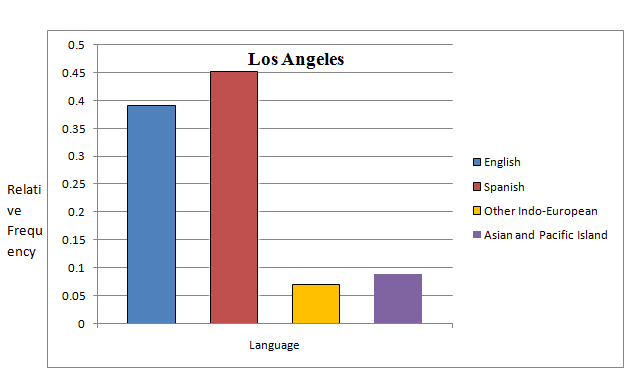
d.
To construct: A relative frequency bar graph for the total.
Explanation of Solution
Given information: The following frequency distribution presents the number of households (in thousands) categorized by the language spoken at home, for the cities of New York and Los An
geles in the year 2009. The total column presents the number of households in both cities combined
| Language | New York | Los Angeles | Total |
| English | 4098 | 1339 | 5437 |
| Spanish | 1870 | 1555 | 3425 |
| Other Indo-European | 1037 | 237 | 1274 |
| Asian and Pacific Island | 618 | 301 | 919 |
Formula used:
Solution:
From the given table,
The sum of all frequency for total city is 11055.
The table of relative frequency for New York city is given by
| Language | Total | Relative Frequency |
| English | 5437 | |
| Spanish | 3425 | |
| Other Indo-European | 1274 | |
| Asian and Pacific Island | 919 |
From the given table, the relative frequency bar graph for the total is given by
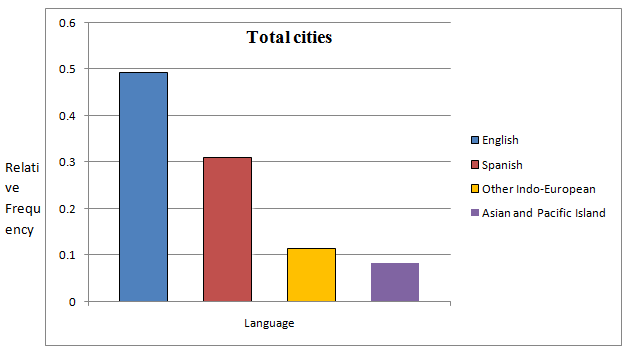
e.
To explain: The heights of the bars for the frequency bar graph for the total are equal to the sum of the heights for the individual cities.
Explanation of Solution
Given information: The following frequency distribution presents the number of households (in thousands) categorized by the language spoken at home, for the cities of New York and Los An
geles in the year 2009. The total column presents the number of households in both cities combined
| Language | New York | Los Angeles | Total |
| English | 4098 | 1339 | 5437 |
| Spanish | 1870 | 1555 | 3425 |
| Other Indo-European | 1037 | 237 | 1274 |
| Asian and Pacific Island | 618 | 301 | 919 |
Since each total frequency of households is the sum of the frequencies for the cities of New York and Los Angeles, therefore, the heights of the bars for the frequency bar graph for the total are equal to the sum of the heights for the individual cities.
f.
To explain: The heights of the bars for the relative frequency bar graph for the total are not equal to the sum of the heights for the individual cities.
Explanation of Solution
Given information: The following frequency distribution presents the number of households (in thousands) categorized by the language spoken at home, for the cities of New York and Los An
geles in the year 2009. The total column presents the number of households in both cities combined
| Language | New York | Los Angeles | Total |
| English | 4098 | 1339 | 5437 |
| Spanish | 1870 | 1555 | 3425 |
| Other Indo-European | 1037 | 237 | 1274 |
| Asian and Pacific Island | 618 | 301 | 919 |
The relative frequency is the frequency divided by the sum of all frequency.
The sum of all frequencies for each city is not equal to the sum of all total frequencies; therefore, the sum of relative frequency for each city will not be equal to the relative frequency for total.
Hence, the heights of the bars for the relative frequency bar graph for the total are not equal to the sum of the heights for the individual cities.
Want to see more full solutions like this?
Chapter 2 Solutions
Elementary Statistics 2nd Edition
- A company found that the daily sales revenue of its flagship product follows a normal distribution with a mean of $4500 and a standard deviation of $450. The company defines a "high-sales day" that is, any day with sales exceeding $4800. please provide a step by step on how to get the answers in excel Q: What percentage of days can the company expect to have "high-sales days" or sales greater than $4800? Q: What is the sales revenue threshold for the bottom 10% of days? (please note that 10% refers to the probability/area under bell curve towards the lower tail of bell curve) Provide answers in the yellow cellsarrow_forwardFind the critical value for a left-tailed test using the F distribution with a 0.025, degrees of freedom in the numerator=12, and degrees of freedom in the denominator = 50. A portion of the table of critical values of the F-distribution is provided. Click the icon to view the partial table of critical values of the F-distribution. What is the critical value? (Round to two decimal places as needed.)arrow_forwardA retail store manager claims that the average daily sales of the store are $1,500. You aim to test whether the actual average daily sales differ significantly from this claimed value. You can provide your answer by inserting a text box and the answer must include: Null hypothesis, Alternative hypothesis, Show answer (output table/summary table), and Conclusion based on the P value. Showing the calculation is a must. If calculation is missing,so please provide a step by step on the answers Numerical answers in the yellow cellsarrow_forward
 Holt Mcdougal Larson Pre-algebra: Student Edition...AlgebraISBN:9780547587776Author:HOLT MCDOUGALPublisher:HOLT MCDOUGAL
Holt Mcdougal Larson Pre-algebra: Student Edition...AlgebraISBN:9780547587776Author:HOLT MCDOUGALPublisher:HOLT MCDOUGAL Glencoe Algebra 1, Student Edition, 9780079039897...AlgebraISBN:9780079039897Author:CarterPublisher:McGraw Hill
Glencoe Algebra 1, Student Edition, 9780079039897...AlgebraISBN:9780079039897Author:CarterPublisher:McGraw Hill Big Ideas Math A Bridge To Success Algebra 1: Stu...AlgebraISBN:9781680331141Author:HOUGHTON MIFFLIN HARCOURTPublisher:Houghton Mifflin Harcourt
Big Ideas Math A Bridge To Success Algebra 1: Stu...AlgebraISBN:9781680331141Author:HOUGHTON MIFFLIN HARCOURTPublisher:Houghton Mifflin Harcourt



